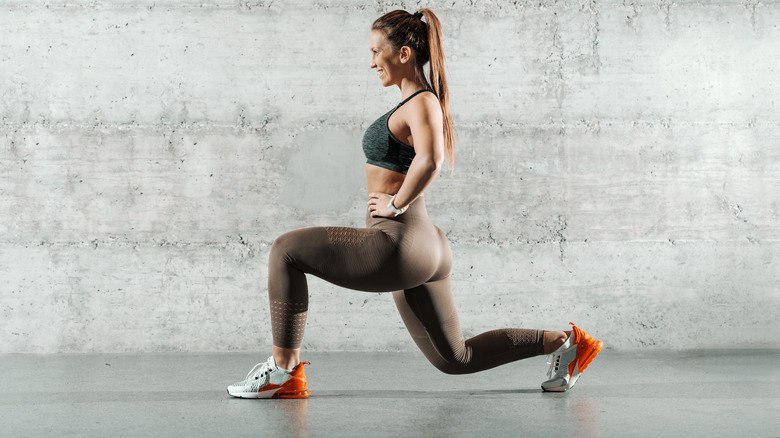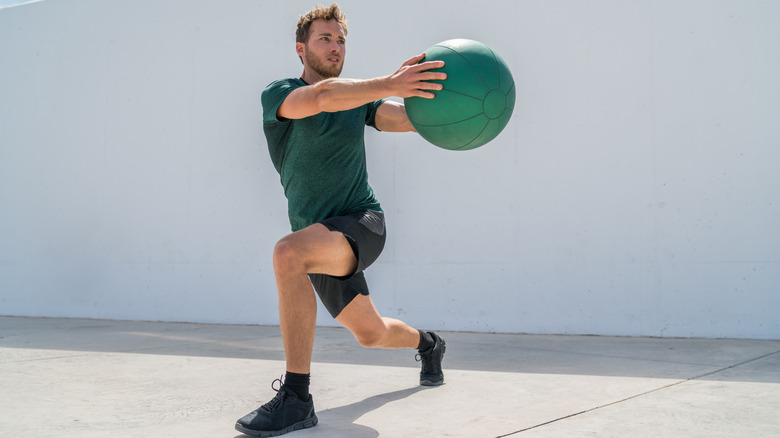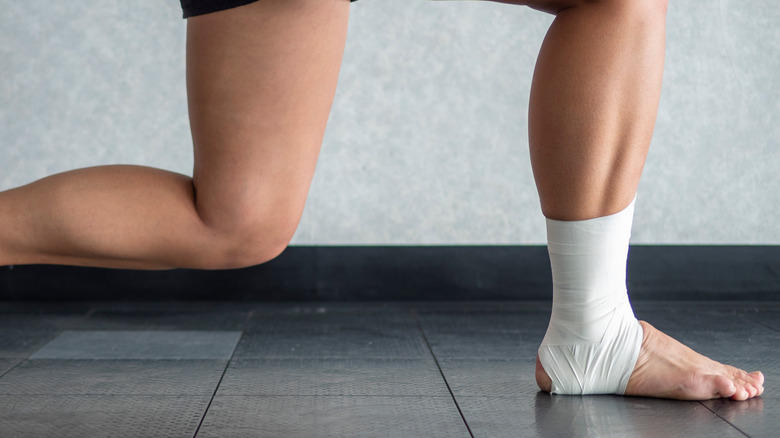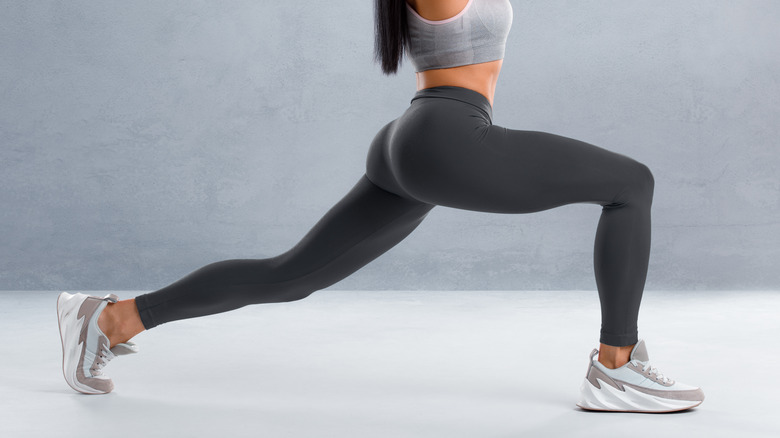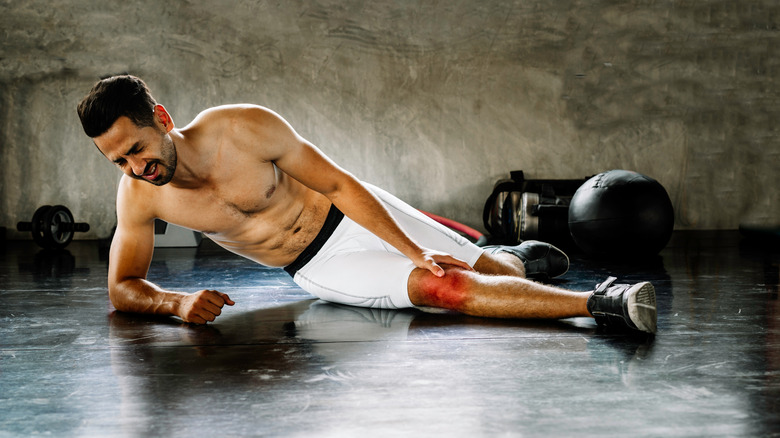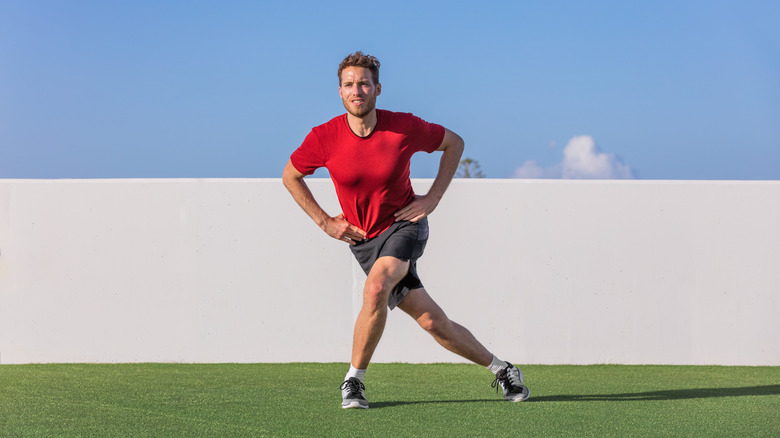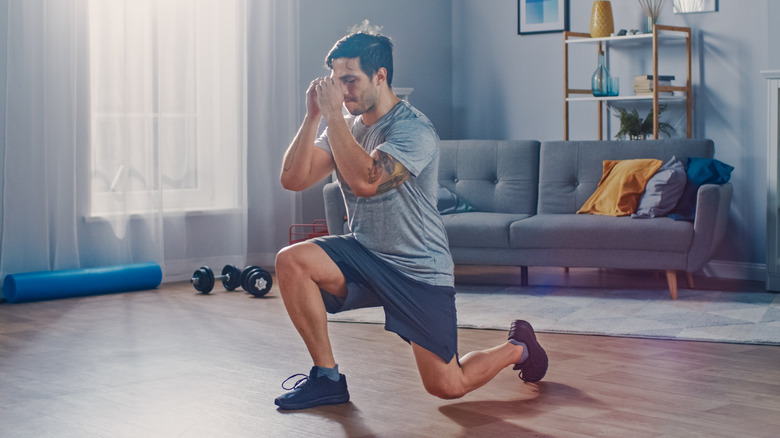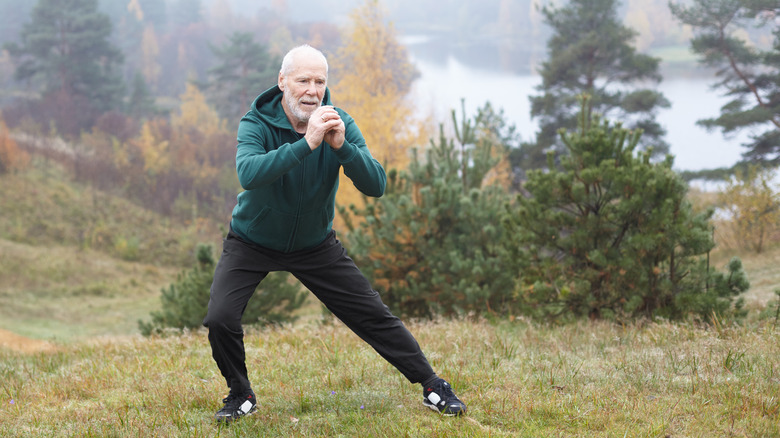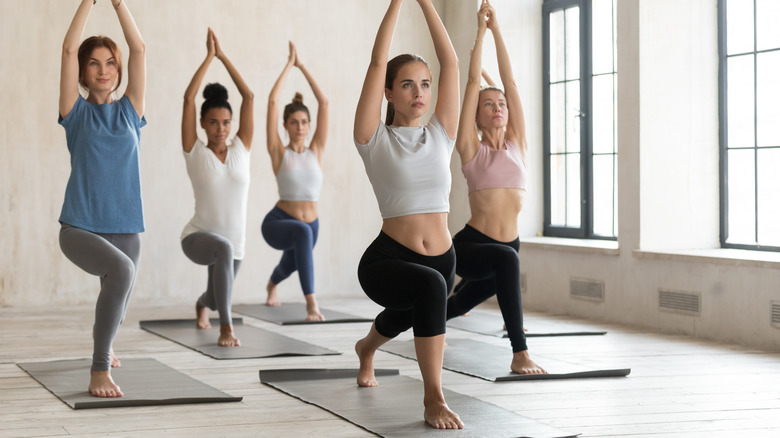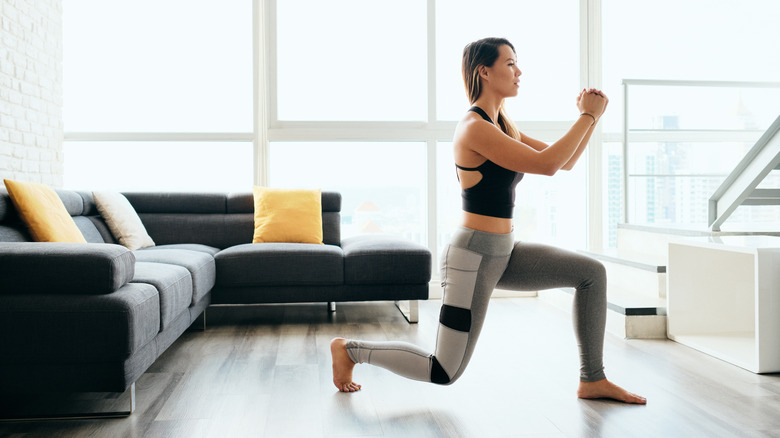When You Do Lunges Every Day, This Is What Happens
Love it or loathe it, the lunge is a staple in every balanced exercise regime. A compound exercise that works multiple muscles in one movement, lunges activate and strengthen many of your major lower body muscles, including your hamstrings, glutes, quadriceps, and calves (via Healthline). Using efficient and functional movement to strengthen your body makes this exercise one of the best out there, both in terms of using your body's natural movements to strengthen your muscles and for the sheer bang you get from each strengthening buck.
With seemingly endless variations on lunges that emphasize different muscles (like a curtsy lunge, which target your glutes), it's easy to switch it up if you get bored of a plain old forward lunge. But you may have wondered what a lunge actually does, and why you're even doing it. And if you're like us, you may have thought this mid-lunge (while sweating and cursing under your breath). Thankfully, we've now got the answers. This is what you can expect to happen if you do lunges every day.
Doing lunges every day can help build your core
When you perform a lunge, your lower body is heavily involved and activated. But the muscles above your pelvis are also working, and a daily lunge regimen even involves your core muscles, strengthening them over time. According to Nicholas Rizzo, biologist and fitness research director at RunRepeat, daily lunges require you to engage your core muscles in order to keep you steady.
Speaking to Livestrong, he said, "Based on what kind of lunge you are doing, there are different levels of stability and balance required. The more balance required, the more your core and back are recruited in these movements, making them effective for improving overall core strength." Certain types of lunges, such as dumbbell lunges, will offer further recruitment for your core and upper body, leading to more resistance and therefore more strength built over time. Other lunges, like a lunge with a twist, target the abdominals more specifically.
It's important to remember, however, that weighted lunges are a higher-intensity movement than bodyweight lunges and, as Livestrong mentioned, doing them every day is inadvisable as your body will require more time to recover.
Lunges are often performed incorrectly, which can lead to injury
Lunges are great if you perform them correctly, but they're very easy to do wrong. If you use improper form, you're going to get yourself into some trouble. As Kathleen Stabler, a certified Gym Jones instructor and the owner of True North Performance Coaching in Albuquerque, New Mexico, told Outside Online, even the fittest of folks can mess up their lunge game. "Really strong people can be really terrible at lunges. The movement is actually very complex, and the potential for injury is high," she explained.
According to Stabler, there are a few common culprits for mistakes, including working through lunges too quickly and sloppily, lunging the knee past the foot, and poor posture. These are problematic as they can lead to injury.
If you're worried that your form might be off, take it slow, focus on your posture and balance, and make sure you're taking sufficiently large steps. After all, as Stabler said, "If you're working hard toward a goal, you want to maximize what you're doing and certainly mitigate any risks."
You'll become a better runner
Doing lunges every day won't just help you develop a more sculpted look in your lower body. The strength you'll gain will also help your performance in other fitness activities, like running.
With lunges strengthening basically every muscle your lower body uses to run, they're a godsend for joggers looking to increase their speed or endurance. Take the hamstrings, for example. Strengthened through lunges, hamstrings "help transfer force down the leg and into the ground for efficient forward propulsion," according to running coach James Dunne (via Runner's World). Yes, stronger hamstrings lead to more powerful and economical forward motion while running or jogging.
Lunges have also been shown to aid running and sprinting ability in studies. According to one such study published in the Journal of Strength and Conditioning Research, a group of soccer players undertook a program of either walking lunges or jumping lunges twice a week for six weeks. At the end of the trial, researchers observed improvements in hamstring strength and sprinting speed. They asserted that "walking and jumping forward lunges can be used for improving hamstring strength and running speed in young soccer players."
You'll build strength in your legs
We know this isn't exactly the most shocking claim, but there's a reason why personal trainers across the world extol the virtues of lunging — it's one of the best exercises for building leg strength. Lunges target your quadriceps and glutes, as well as other important lower body muscles (via Livestrong), This makes them a key tool in your #legday arsenal.
It's important to bear in mind, though, that while lunges are excellent for building strength, you'll likely need to switch things up to avoid a fitness plateau. Luckily for you, lunges come in all shapes, sizes, and variants, and they all exercise your lower body in unique ways.
For example, reverse lunges can offer an alternative to the forward motion of a regular lunge. As Simon King, a personal trainer and the owner of Cre8 Fitness in London, told Men's Journal, "Though it may stress the knee joint less, it still delivers big results when it comes to muscle and strength development. It can also be used as an assessment tool to evaluate muscle and structure imbalances while developing balance, strength, and hip flexibility through movement."
Side lunges can train some 'under-appreciated' muscles
Only lunging forward is so last year. We invite you to step into a brave new world and try — drumroll, please — lunging to the side. While this move may not be your go-to lunge, it's an incredible exercise for strengthening your lower body muscles.
As New York City-based trainer Rachel Mariotti told Shape, "The side lunge is a great exercise because it works the sides of the glutes (the gluteus medius), which are important stabilizer muscles for the hip joint, and are often under-appreciated." Helping with hip rotation and healthy movement of the leg at the hip joint, the gluteus medius is less well-known than its bigger, brasher sibling gluteus maximus(via Verywell Health). But it's as important for correct lower body function, and a side lunge can help it get the love it needs.
Also, according to Mariotti, side lunges can help to work your quadriceps from a different angle, keeping them challenged. When performing a side lunge, it's important to keep the glutes activated when pushing back up and to keep the knee from coming forward over the toes to maintain good form.
Overtraining could lead to worse results
Doing lunges daily sounds like a decent way to get your lower body super strong, but it could make things worse, as you run the risk of overtraining. This could leave you with a host of problems, according to Nicholas Rizzo, biologist and fitness research director at RunRepeat.
He told Livestrong, "Lunges can be a demanding movement and certainly can be done too much. The obvious signs of over-exercising, like muscles being too sore, being tired and worn down and being overall weaker all apply to lunges." Rizzo further explained that if you do too many lunges, "your form will be significantly worse and be less consistent from repetition to repetition."
Theresa Marko, a board-certified clinical specialist in orthopedic physical therapy and owner of Marko Physical Therapy, takes a similar view and points towards injury risk. As she told the publication, "You do not want to work the same muscles over and over without giving them recovery time. This will lead to tendonitis, muscle strains due to tightness/trigger points and possible joint issues." Rest days are vital; the body needs time to repair and recover (via Healthline).
You can increase your hip mobility and strength
The rise of working from home in 2020 has meant more time sitting in a chair than ever before, and less daily mobility can lead to tighter or weaker hips. As personal trainer Rachel Tavel wrote in an article for Self, hip tightness or weakness can lead to discomfort when practicing day-to-day activities and can even have an impact on other parts of your body, like your knees.
If you're concerned about your hip strength, incorporating lunges into your daily routine could be a great way to keep them healthy. As Tavel wrote, "The lunge is a great way to exercise the hips." She also suggested adding in different lunge variations, saying, "By mixing up your lunge workout to include variations that get you moving in all directions, you can more adequately strengthen your hips in all the ranges of motion in which they're meant to move. Which, actually, is a lot." Tavel pointed not only to forward and reverse lunges, but also curtsy lunges, side lunges, and reverse lunges with rotations to get your hips moving.
If you do reverse or static lunges, you'll put less stress on your knees and increase stability
The classic forward lunge can be great for lower body strength, but it can impact your knee joints pretty heavily. Personal trainer Dani Singer told Aaptiv that forward lunges are often performed with incorrect form, with people moving too quickly in and out of a lunge, putting their knees in unsafe weight-bearing positions, or performing them with an intensity that's too high for their fitness level. All of these things could lead to injury.
If you worry about your knees during lunges, try reverse lunges. According to Healthline, reverse lunges activate the same muscles as in a regular lunge, but the motion puts less stress on your knees. Reverse lunges also offer greater stability on your front leg.
A static lunge, as certified personal trainer Meg Lappe explained in an article for Self, is also a great choice. To reduce pressure on your knees, Michelle Rodriguez, personal trainer and member of Manhattan Physio Group in New York, advised, "The best thing you can do is to make the lunge be static."
You may end up with a stronger, bigger butt
If you're after a bigger or stronger butt, performing lunges every day could be one of the best ways to work towards it. According to the Houston Chronicle, "When you lunge, the hip extension that occurs causes your glute muscles to fire."
Certain variations of a lunge, such as a walking lunge, can provide an even greater workout due to the balancing that your muscles have to do. And as Ben Bruno of Mike Boyle Strength and Conditioning told the publication, a goblet walking lunge could be a great exercise to add further resistance.
Building glutes isn't important just for aesthetic reasons. As Dr. Jordan Metzl, an exercise physician and author of "The Exercise Cure," told Active, "[Your glutes are] one of the workhorses of the body." They're involved in basically every movement performed by your lower half. Metzl also pointed to the fact that too-weak glutes can cause other muscles, such as your hamstrings, to compensate, which can cause injuries. Keeping them strong is a wise move.
You might boost your metabolism
Your metabolism — the term for the way and speed with which the body burns energy — is determined by several factors, according to Dr. Tim Church, professor of preventive medicine at Pennington Biomedical Research Center at Louisiana State University.
Speaking to Self, he pointed out that among other things that determine your metabolic rate (including, interestingly, the size of your organs!), your level of muscle mass can increase how quickly you burn calories. Church explained that for each pound of muscle you have, your body burns roughly 6 calories per day while resting, compared to 2 calories a day per pound of fat.
So, the more muscle you build through exercises like lunges, the more calories you'll burn. Also, due to lunges being a compound exercise, the very exercise itself burns more calories than many others. As Simon King, a personal trainer and the owner of Cre8 Fitness in London, told Men's Journal, "Compound exercises like lunges elicit a huge metabolism response, meaning you burn [a ton of] calories."
Daily lunges can protect the bone density in your lower body
A daily glass of milk isn't the only way to keep your bones strong. The one and only superstar personal trainer Jillian Michaels extolled the virtues of lunges to Insider, saying, "Lunges work multiple larger muscle groups at the same time. They build lower body strength and help to maintain muscle mass and bone density in the lower body."
According to Harvard's Healthbeat, this occurs when stress is placed on bones, which spurs bone-forming cells to create mass and density within your bones. While this is useful at any time of life, it's particularly important to keep aware of your bone density as you age. Bone mass decreases by roughly 1% per year after the age of 40. This can lead to the development of osteoporosis, which increases your chance of fractures, particularly to your hips (via Mayo Clinic). To help prevent this, take Michaels' word for it and get lunging!
Your balance and posture will improve
If you've ever marveled at the grace of a personal trainer moving into a perfect lunge, know that if you were to perform this movement regularly, you could also achieve impressive balance and posture. As Healthline pointed out, lunges can help your balance and posture by not only increasing your primary leg muscle strength but also working your stabilizer muscles and the muscles in your back and core.
It's important to remember, too, that balance and posture aren't just important when it comes to exercise. Harvard Women's Health Watch explained that balance is a huge factor for reducing the risk of falls in older adults and women with low bone mass. Balance training can be beneficial because it "improves postural stability after a stroke" or other conditions that affect balance and posture, according to the publication. While daily lunges may or may not feature in more specific instances of balance training, practicing a lunge is an excellent way to help with alignment.
You might sleep better if you do lunges every day
Daily lunges improve your sleep quality, and not just because you'll feel tired after doing them. There's a strong link between exercise and better sleep, and while this link is often seen most strongly in aerobic exercise, don't count out lunges just yet.
According to a study published in Preventive Medicine Reports, which looked at the link between muscle strengthening exercise and sleep among over 23,000 German adults, resistance exercises increased sleep quality, with the study's authors writing, "Future health behavior modification strategies to enhance sleep quality at the population-level should consider promoting muscle-strengthening exercise."
According to Dr. W. Chris Winter, president of Charlottesville Neurology and Sleep Medicine and author of "The Sleep Solution," this is due to the production of adenosine, a molecule that promotes drowsiness. Speaking to Runner's World, he said, "Compared to lighter exercise like a leisurely run, strength training tends to create a bigger surge of adenosine." Thus, it helps people drift off to sleep. With the muscle-strengthening benefits that lunges provide, you could be getting ripped during the day and sleeping like a baby at night.
Your heart health could improve, especially when you combine lunges with cardio
We usually associate improved heart health through exercise with cardio, and it's certainly true that doing cardio can strengthen your heart and blood vessels and improve your blood pressure (via UT Southwestern Medical Center). It doesn't have to just stop there, though. A daily lunge regimen could offer further benefit to your heart health, particularly when combined with cardio.
A survey of 4,000 adults found that strength training was linked to a reduced risk of cardiovascular disease (via Medical News Today). While the survey appeared to show that strength training offered more reduction in the risk in cardiovascular health, Dr. Maia P. Smith, an assistant professor in the Department of Public Health and Preventive Medicine at St. George's University in Grenada, said "static activity appeared more beneficial than dynamic," she was keen to stress that people "fared better" when doing both resistance training and dynamic, cardio-based exercise.
Nonetheless, Smith stated that "both strength training and aerobic activity appeared to be heart healthy, even in small amounts, at the population level." This is great news for lunge lovers.

